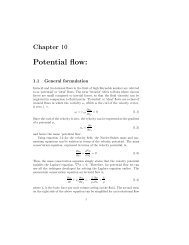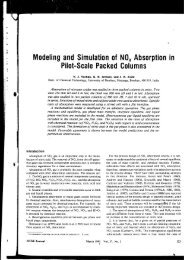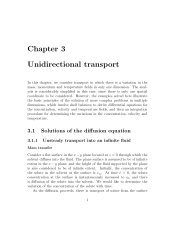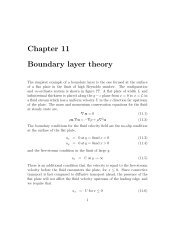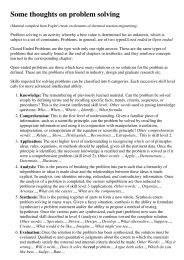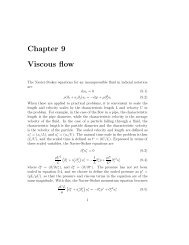Chapter 5 Steady and unsteady diffusion
Chapter 5 Steady and unsteady diffusion
Chapter 5 Steady and unsteady diffusion
Create successful ePaper yourself
Turn your PDF publications into a flip-book with our unique Google optimized e-Paper software.
6 CHAPTER 5. STEADY AND UNSTEADY DIFFUSION<br />
K p<br />
∂T p<br />
∂r<br />
= K m<br />
∂T m<br />
∂r<br />
(5.22)<br />
Though the temperature field is disturbed by the presence of the particle near<br />
the particle surface, it is expected that the temperature field is unaltered at<br />
a large distance from the particle r → ∞, where it is given by<br />
T = T ′ x 3 = T ′ r cos (θ) (5.23)<br />
The temperature field far from the particle can be expressed in terms of<br />
the Legendre polynomial solutions for the Laplace equation as<br />
T = T ′ rP 0 1 (cos (θ)) (5.24)<br />
Since the temperature field is driven by the constant temperature gradient<br />
imposed at a large distance from the particle, it is expected that the temperature<br />
field near the particle will also be proportional to P1 0 (cos (θ)), since<br />
any solution which contains other Legendre polynomials is orthogonal to<br />
P (0)<br />
1 (cos (θ)). Therefore, the solutions for T p <strong>and</strong> T m have to be of the form<br />
T p<br />
T m<br />
= A p1 rP1 0 (cos (θ) + A p2<br />
r P 0 2 1 (cos (θ))<br />
= A m1 rP1 0 (cos (θ) + A m2<br />
r P 0 2 1 (cos (θ)) (5.25)<br />
The constant A p2 is identically zero because T p is finite at r = 0, while<br />
A m1 = T ′ in order to satisfy the boundary condition in the limit r → ∞.<br />
The constants A p1 <strong>and</strong> A m2 are determined from the boundary conditions at<br />
the surface of the sphers,<br />
3T ′<br />
A p1 =<br />
2 + K R<br />
A m2 = (1 − K R)R 3<br />
(5.26)<br />
2 + K R<br />
The temperature fileds in the particle <strong>and</strong> the matrix are<br />
T p =<br />
3T ′ r<br />
P1 0 (cos (θ)<br />
2 + K R<br />
T m = T ′ rP1 0 (cos (θ) + (1 − K R)R 3 T ′<br />
P 0<br />
(2 + K R )r 2 1 (cos (θ)) (5.27)





